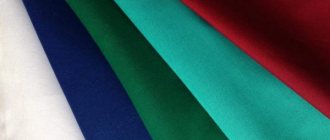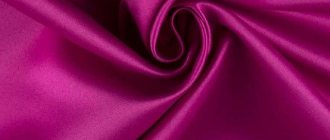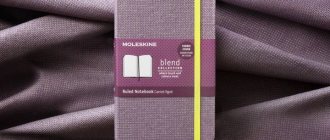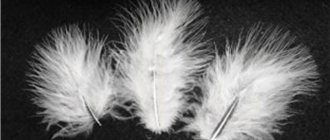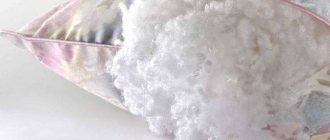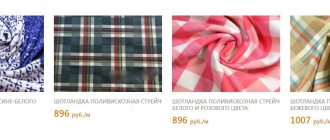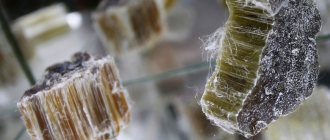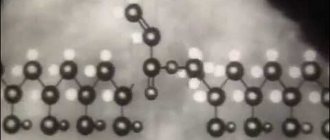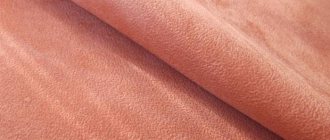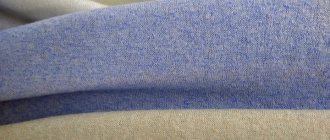What is holofiber?
This is a synthetic non-woven fiber of the polyester group. The structure is very similar to padding polyester, but differs in the absence of the use of glue in production. Holofiber is based on spiral-shaped silicone fiber, which is held together by soldering at high temperature. The result is long fibers.
What is holofiber?
Description of insulation
It must be said right away that this material is often called holofiber , but this word is correctly spelled “holofiber”.
The best heat insulator is air. Both builders and clothing companies remember this rule. Therefore, when creating insulation materials, it is important to create a material whose fibers will retain air. Hollofaber is just such a filler. It is a hollow fiber twisted into a spiral. The great advantage of this material is that during production the fibers are not glued together, but soldered. As a result, the use of substances harmful to human health is reduced to a minimum.
In addition, holofiber, due to its structure , is very durable. It does not deteriorate due to physical stress such as squeezing, washing and the like.
Holofiber comes in three types:
- Balloons;
- Layers;
- Rolls.
Externally, this filler resembles synthetic fluff. But its structure is not uniform, but consists of small lumps. This is a very good insulation material, clothes made from which can easily withstand 25-degree frosts. In some ways it is similar to widespread artificial fillers, which is why it is often called siliconized padding polyester. A variety of this material is isosoft; it is more expensive and more difficult to produce.
If during production the material was processed in a heat chamber, then a new, more advanced type of filler is obtained - thermofiber. It not only retains heat , but also does not deform at all after washing. Another improved version of the original material is holophane (or holophan), which is a lightweight non-woven fabric suitable for sewing clothes.
In addition, there are several categories of holofiber, which differ from each other in density:
- Software Available in rolls and used for sewing outerwear.
- Volumetric. Volume filler. More suitable for stuffing children's toys.
- Medium and Hard, which are intended for the production of upholstered furniture.
- Build, Agro and so on. Some types of material are used in the space and aviation industries, as well as in arranging ventilation.
Holofiber filler: pros and cons
This material has many positive properties:
- Light weight
- Excellent thermal conductivity and heat retention ability
- Low price
- Hypoallergenic
- Does not absorb odors
- Not electrified
This insulation has no negative aspects. Except that it is slightly inferior in heat capacity to a goose feather.
Holofiber filler: pros and cons
Holofiber: what temperature and weather is it designed for?
Now there is a huge amount of outerwear with holofiber on the market. This is due to the low price. A down jacket costs one and a half times cheaper than a natural one. At the same time, it is not inferior in quality. Before answering about temperature standards, it is worth deciding on the density of the filler. The minimum operating temperature also depends on this figure.
Temperature standards:
- Density 100 g/sq.m. — from +10°С to +5°С
- Density 150 g/sq.m. — from +5°С to -10°С
- Density 200 g/sq.m. — from -10°С to -20°С
- Density 300 g/sq.m. – from -20°С to -30°С
Holofiber: what temperature and weather is it designed for?
Where is holofiber used?
Holofiber is a popular synthetic filling for bedding - pillows and blankets. This is the main area of its application. The products are soft, light, durable, and do not cause allergic reactions. Blankets and pillows with holofiber are recommended even for children.
Due to its high thermal insulation properties, the material is used as insulation in the manufacture of winter outerwear. Jackets and coats with holofiber can withstand frosts down to 15 °C.
The material is used for stuffing soft toys and in the manufacture of furniture - sofas, armchairs, chairs, but more often manufacturers use cheaper padding polyester instead.
What is the difference between padding polyester and holofiber?
In principle, the material is made from the same fiber, but using different technologies. Sintepon is a type of silicone fiber, like holofiber, but all the fibers in it are glued. In holofiber, the threads are connected to each other by soldering at high temperatures without the use of glue. There is emptiness inside the fibers, which makes the material light and very warm. Thus, holofiber is much lighter and warmer than padding polyester.
What is the difference between padding polyester and holofiber?
What is warmer and better: holofiber or padding polyester, artificial and natural down?
Synthetic winterizer is not the best insulation, as it gets wet and accumulates moisture. At the same time, the material has a low thermal insulation rate. It is an order of magnitude higher than holofiber.
Natural down is a competitor to holofiber. Products made from it are as warm as possible. But down has one huge drawback - the price. In addition, down gets wet in rainy weather. There are also some difficulties when washing down jackets with natural feathers. If we take into account all these indicators, then holofiber is an ideal option.
What is warmer and better: holofiber or padding polyester, artificial and natural down?
How to care for products
Outerwear, blankets and other products made from holofiber can be safely washed in an automatic machine, but the temperature regime must be observed. Water should not exceed 40 degrees. The material can also be washed by hand with pre-soaking. Products can be ironed and steamed.
Holofiber items can be dried in a washing machine that has the appropriate function. To care for products containing this material, it is recommended to use liquid detergents instead of powders. They are much easier to rinse out of holofiber.
Washing gel is the best option for caring for holofiber
Pillows and blankets made from this material should be washed using the delicate cycle. You will need 2 times less powder than when washing ordinary things, otherwise its residues will linger in the fibers. Spinning will not damage the holofiber; the pillow will quickly restore its shape after drying.
The furniture is also easy to care for. If dirt appears on the woven surface, you will need to treat it with a special powder or use laundry soap, after wetting the stained area. Then carefully clean the area of contamination with a sponge and warm water.
Caring for furniture made from holofiber is not difficult
If the holofiber can be pulled out, this will make it easier to care for furniture with such filling. It is enough to remove the layer, wash the cover, and air the material itself on the balcony. You don't need to do anything else with it. If the holofiber cover is always clean, then this is enough. If the layer itself is dirty, then you can use washing gel diluted in warm water (1 tablespoon of product per 2 liters of water). Wet the sponge in the solution and thoroughly rub the stained area. Then let the surface dry and then use the cover.
You cannot wash the material without a fabric bag. It is not recommended to remove fibers from the pillow and rinse them separately, otherwise the structure will be damaged.
The author of these lines has a holofiber down jacket. It is easy and simple to wash when it gets dirty. I set the delicate mode and temperature to 40 degrees. I wash my down jacket for an hour. When using powder, I turn on the additional rinse mode. The down jacket dries in just a couple of hours. Unlike synthetic down and synthetic padding, the material does not roll into lumps after washing and the clothes look like new.
Is it possible and how to wash holofiber in a washing machine?
Yes, products made from this filler can be safely machine washed. In this case, it is worth taking into account the features of the upper fabric. After all, holofiber can be washed even at a temperature of 80 °C. But due to the fact that down jackets are dyed and made of raincoats, the optimal washing temperature is 40 °C. At the same time, the products can be wrung out, because holofiber straightens out perfectly after washing and spinning. It doesn't need to be shaken off like fluff.
You can wash not only down jackets, but also blankets, pillows and bedspreads with holofiber. These are the products that can get dirty. Only now there is no need to take them to dry cleaning. You can wash it yourself in a washing machine.
Is it possible and how to wash holofiber in a washing machine?
Holofiber is an excellent filler that will serve as an excellent alternative to natural fluff. It's just as warm, but much cheaper.
Areas of use
Holofiber is a trademark. It produces a number of products that have heat-insulating properties and are used as insulation.
The scope of application is wide:
- Construction;
- Upholstered furniture and toys;
- Outerwear and professional clothing and headwear;
- Bed dress;
- Cleaning and filtration systems.
It is quite voluminous and has a porous structure. This makes it simply irreplaceable in construction. Such characteristics give it soundproofing properties, and it also retains heat well. It can be used both for multi-storey construction and for private houses. By laying it in the space between the walls, you can reduce the amount of external noise.
Using holofiber slabs as insulation, you can forget about the penetrating wind and cold for a long time. If you want to insulate your balcony, then pay attention to this material.
Holofiber is an environmentally friendly product. It’s not for nothing that Termopol, which produces it, was called a “plant without pipes.” It does not spew tons of harmful substances into the atmosphere and does not discharge into rivers and canals. This confirms the safety of using the filler for children's clothing and toys.
It is non-toxic and does not cause allergies. In 2010, the Holofiber brand was awarded the title of “Well-known Trademark” and received a certificate confirming its hygienic and environmental safety. This suggests that even direct contact of the material with the child’s skin is allowed.
Several types of filler are used for upholstered furniture. They vary in density, so some are form-forming and others are not.
There are:
- Holofiber soft insulation (soft). Used for quilted elements, as well as as a forming top layer of soft parts;
- Medium (average). It is a substitute for block polyurethane foam. Serves as a formative top layer;
- Hard (hard). It is used as a structural and flooring material for upholstered furniture elements.
It also serves as an excellent option as insulation for raincoats and jackets. It makes the product incredibly light and comfortable. Such jackets are in no way inferior to down jackets in their characteristics. The advantage is that they do not require special care. You can easily wash the product in a washing machine without fear of the fibers becoming deformed.
But most often, holofiber is still used as a filler for blankets and pillows. This is simply a salvation for people suffering from allergies. The most common cause is dust mites. Hollofiber “does not attract” dust, therefore it is an unfavorable environment for the reproduction of these “creatures”. Sensitive people will certainly appreciate sleeping on pillows with this filling.
Perfect for special pillows for pregnant women, creating comfortable use and a minimum of worries.
Another not entirely traditional area of application for this material is filtration systems. Holofiber can be used as an air filter. This is possible thanks to the porous multilayer structure. However, in this case it is necessary to pay attention to the location of the fibers - it should not be vertical.
Using holofiber for upholstered furniture in the video:
